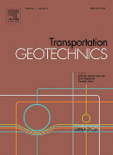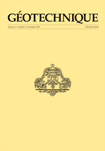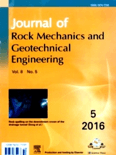
Geotechnical Engineering
Scope & Guideline
Pioneering Research in Geotechnical Sciences
Introduction
Aims and Scopes
- Soil Mechanics and Behavior:
Research on the mechanical properties and behavior of various soil types, including soft clays, expansive soils, and tropical soils, emphasizing their response under different loading conditions. - Ground Improvement Techniques:
Investigation into various methods for enhancing soil properties, such as the use of geosynthetics, chemical stabilization, and innovative materials like nanomaterials and biopolymers. - Geotechnical Risk and Stability Analysis:
Focus on the stability of slopes, foundations, and earth structures, particularly under adverse conditions such as seismic activity, rainfall, and land subsidence. - Application of Advanced Technologies:
Integration of modern technologies in geotechnics, including numerical modeling, IoT applications for monitoring, and the use of artificial intelligence in soil property estimation. - Environmental and Sustainability Considerations:
Research addressing the environmental impact of geotechnical practices, including waste management, use of byproducts, and sustainable construction materials.
Trending and Emerging
- Nanotechnology and Biopolymers in Soil Engineering:
An increasing number of studies explore the use of nanomaterials and biopolymers to improve the mechanical properties of soils, showcasing a trend towards sustainable and innovative materials in ground improvement. - Real-time Monitoring and IoT Applications:
Research on the development and application of IoT systems for real-time monitoring of geotechnical structures is gaining traction, emphasizing the importance of data-driven decision-making in geotechnical engineering. - Seismic Analysis and Earthquake Engineering:
A renewed focus on seismic analysis techniques in geotechnical engineering, particularly in areas prone to earthquakes, highlights the importance of understanding soil behavior under dynamic loading conditions. - Sustainable Geotechnical Practices:
There is a growing emphasis on sustainability, with studies exploring the use of recycled materials and waste products in geotechnical applications, reflecting broader environmental concerns. - Advanced Numerical Modeling Techniques:
The use of sophisticated numerical modeling tools to simulate complex geotechnical problems is on the rise, indicating a shift towards more detailed and accurate assessments of soil-structure interactions.
Declining or Waning
- Traditional Soil Stabilization Techniques:
There has been a noticeable decrease in research focused on conventional soil stabilization methods, such as lime and cement treatment, as newer, more innovative materials and methods gain attention. - Basic Soil Property Testing:
Research concentrating on fundamental soil property tests, such as standard penetration tests or simple unconfined compressive strength tests, has become less prominent as the field moves towards more complex and integrated testing methodologies. - Static Analysis of Soil Structures:
Static analysis approaches in geotechnical design are being overshadowed by dynamic and probabilistic methods, reflecting a shift towards understanding complex behavior under varying conditions.
Similar Journals

Magazine of Civil Engineering
Exploring New Frontiers in Construction and EngineeringMagazine of Civil Engineering, published by ST-PETERSBURG STATE POLYTECHNICAL UNIVERSITY, is a prominent open access journal dedicated to the field of civil and structural engineering. With an ISSN of 2712-8172 and E-ISSN 2071-0305, it serves as a vital platform for disseminating high-quality research, innovative methodologies, and current trends in building and construction. Since its inception in 2010, the journal has embraced open access, ensuring broad visibility and accessibility for its contributions to the academic community. The magazine holds a respectable position in the academic hierarchy, ranked in the Q3 quartile for both Building and Construction and Civil and Structural Engineering categories as of 2023. It is indexed in Scopus, amplifying its societal impact and reach with a rank of #114/223 in Building and Construction and #224/379 in Civil and Structural Engineering. Researchers, professionals, and students alike are encouraged to engage with the cutting-edge studies presented in the magazine, contributing to the advancement of knowledge and practice within the civil engineering domain.

Soil Mechanics and Foundation Engineering
Bridging Disciplines for Sustainable Engineering SolutionsSoil Mechanics and Foundation Engineering, published by SPRINGER, is a prestigious academic journal dedicated to the dynamic fields of soil mechanics and foundation engineering. With a history spanning from 1964 to 2024, this journal serves as a vital platform for researchers, professionals, and students looking to advance their knowledge and explore innovative techniques in soil behavior, foundation design, and geotechnical engineering. Although the journal does not currently operate under an open access model, it remains essential for its contributions to key disciplines, notably in energy, geotechnical engineering, ocean engineering, soil science, and water science. Positioning itself in the third quartile of various categories in the 2023 rankings, it reflects a commitment to maintaining rigorous research standards despite its competitive environment. The unique intersection of its scope allows for multidisciplinary collaboration, making it an invaluable resource for those aiming to tackle the challenges in foundation systems and soil interactions in diverse engineering applications.

PROCEEDINGS OF THE INSTITUTION OF CIVIL ENGINEERS-GEOTECHNICAL ENGINEERING
Elevating Standards in Earth Sciences and Geotechnical EngineeringPROCEEDINGS OF THE INSTITUTION OF CIVIL ENGINEERS-GEOTECHNICAL ENGINEERING, published by Emerald Group Publishing Ltd, is a prestigious journal that serves the dynamic field of geotechnical engineering and broader earth sciences. With an ISSN of 1353-2618 and an E-ISSN of 1751-8563, this journal has established itself as a vital resource for researchers, professionals, and students alike, offering insights into innovative practices and developments within the geotechnical domain. It ranks within the Q2 category for Earth and Planetary Sciences and Geotechnical Engineering as of 2023, demonstrating its significant impact and relevance in these fields. Given its comprehensive scope from 1994 to 2024, the journal provides a platform for high-quality research articles, case studies, and technical notes, although it presently does not offer open access options. Researchers seeking to publish their work will find this journal an essential venue for reaching an audience deeply invested in the advancement of geotechnical methodologies and solutions.

Transportation Geotechnics
Transforming Transportation Through Geotechnical Excellence.Transportation Geotechnics is a premier academic journal published by Elsevier, focusing on the intersection of geotechnical engineering and transportation systems. With an impressive impact factor and categorized in the Q1 quartile across multiple disciplines including Civil and Structural Engineering, Geotechnical Engineering, and Transportation, this journal stands as a vital resource for researchers and practitioners alike. It covers a broad spectrum of topics ranging from soil behavior in transport contexts to innovative materials and methods that enhance infrastructure stability and performance. As an essential platform fostering knowledge dissemination, Transportation Geotechnics enables contributors to share their groundbreaking findings while providing readers with access to cutting-edge research and reviews from 2014 to 2024. Its illustrious Scopus rankings place it prominently in the global research landscape, making it an indispensable tool for students, professionals, and academics dedicated to advancing the field.

Geotechnik
Advancing Geotechnical Knowledge for a Sustainable FutureGeotechnik, published by ERNST & SOHN, is a prestigious journal in the field of Geotechnical Engineering and Engineering Geology. With its roots tracing back to 1982 and regular publications since then, it provides a vital platform for researchers, practitioners, and students to share and disseminate cutting-edge findings, methodologies, and techniques. The journal's ISSN is 0172-6145 and the E-ISSN is 2190-6653. Notably, it has achieved a commendable Q3 category ranking in 2023, reflecting its contribution to advancing knowledge in its field, as indicated by its Scopus rank of #171 out of 229 in the Earth and Planetary Sciences category. Although it does not offer open access, the journal remains integral for professionals aiming to stay informed about current trends and breakthroughs in geotechnics. Geotechnik strives to underpin its objectives of fostering quality research and encouraging innovation within the geotechnical community, ensuring it remains a crucial resource for all stakeholders involved.

GEOTECHNIQUE
Transforming Insights into Engineering ExcellenceGEOTECHNIQUE is a prestigious peer-reviewed journal published by Emerald Group Publishing Ltd, specializing in the fields of Geotechnical Engineering and Earth and Planetary Sciences. Established in 1948, this journal has consistently delivered groundbreaking research and advancements in the science of soil and rock mechanics, engineering geology, and environmental applications, aiming to foster innovation in geotechnical practices. With an impressive impact factor reflected in its Q1 ranking within both the Earth and Planetary Sciences and Geotechnical Engineering categories, GEOTECHNIQUE is recognized as a leading source of scholarly articles, positioning itself among the top 5% in the field. The journal is accessible via subscription, providing a repository of invaluable insights for researchers, professionals, and students striving to push the boundaries of knowledge and application in geotechnical topics. With a robust editorial board and a commitment to excellence, GEOTECHNIQUE continues to contribute significantly to the academic community and the practical engineering landscape.

Soils and Rocks
Exploring the Depths of Soil and Rock MechanicsSoils and Rocks is an academic journal dedicated to the field of Geotechnical Engineering and Engineering Geology, published by the Brazilian Association of Soil Mechanics and Geotechnical Engineering in collaboration with the Portuguese Geotechnical Society. Since becoming an Open Access platform in 2011, this journal has provided a vital publication outlet for researchers and professionals seeking to disseminate their findings on soil behavior, rock mechanics, and related topics within an international context. The journal is indexed in Scopus, holding a rank of 177 out of 229 in its category as of 2023, placing it in the 22nd percentile among its peers. Operating out of Brazil, Soils and Rocks encourages rigorous scholarly exchange and exploration of innovative practices within the sectors, making it an important resource for advancing knowledge in the geotechnical community. With a converged publication history from 2007 to 2024, the journal aims to foster significant advancements and insights that enhance our understanding of subsurface conditions and materials.

Transportation Infrastructure Geotechnology
Exploring the Nexus of Geotechnology and Civil Engineering.Transportation Infrastructure Geotechnology, an esteemed journal published by SpringerNature, serves as a vital platform in the fields of Civil and Structural Engineering, Environmental Engineering, Geotechnical Engineering, and Transportation. Established in 2014 and spanning a decade of significant scientific discourse, this journal has gained recognition for its robust contribution to the understanding of the interplay between geotechnical processes and transportation infrastructure. With an impactful Q2 ranking in multiple categories—including Civil and Structural Engineering and Environmental Engineering—it emphasizes innovative research and practical applications globally. Researchers and professionals can explore critical topics that influence infrastructure sustainability, safety, and efficiency. Although it operates under a subscription model, its affiliation with SpringerNature ensures rigorous peer-review and high-quality publications, making it an indispensable resource for academics and industry experts alike.

Geotechnical Research
Bridging theory and practice in earth sciences.Geotechnical Research is an esteemed scholarly journal published by EMERALD GROUP PUBLISHING LTD, dedicated to advancing the field of geotechnical engineering and earth sciences. With an impact factor reflective of its robust contributions, this open access journal has been providing unrestricted access to high-quality research since 2014, making it indispensable for researchers, professionals, and students alike. The journal, indexed under the ISSN 2052-6156, features rigorous peer-reviewed articles that encompass a wide range of topics within geotechnical engineering and engineering geology, achieving a notable placement in the Q2 category in both Earth and Planetary Sciences and Geotechnical Engineering as of 2023. With its Scopus ranks further affirming its significance—ranked #44 out of 159 in Earth and Planetary Sciences and #78 out of 229 in Geotechnical Engineering—Geotechnical Research stands as a vital resource for innovative solutions and advancements in this critical field, ensuring researchers access to essential insights that drive the discipline forward.

Journal of Rock Mechanics and Geotechnical Engineering
Pioneering Innovations in Rock Mechanics and Engineering GeologyThe Journal of Rock Mechanics and Geotechnical Engineering is a premier open-access publication dedicated to advancing the field of geotechnical engineering and engineering geology. Published by SCIENCE PRESS and based in China, this journal has been a vital resource for researchers and professionals since it transitioned to open access in 2013. With ISSN 1674-7755 and E-ISSN 2589-0417, it has established a global reputation, evidenced by its impressive Q1 ranking in the category of Geotechnical Engineering and Engineering Geology as well as a remarkable 8th rank out of 229 in Earth and Planetary Sciences, placing it in the 96th percentile according to Scopus. The journal aims to publish high-quality research that addresses contemporary challenges in the field, offering insightful perspectives and innovative solutions. Researchers, professionals, and students are encouraged to engage with the latest findings and methodologies published within its pages, which span from 2013 to 2024 and continue to pave the way for future advancements in geotechnical practices.